10 Hidden Gems in Kyoto You Need to Discover
As you plan your next visit to Kyoto, you might think you've seen all it has to offer, but the city holds secrets away from the usual tourist trails that await your discovery. Imagine wandering through the quiet, moss-covered grounds of Gio-ji Moss Garden, or finding solace among the stone faces of Otagi Nenbutsu-ji's statues. Each hidden gem in Kyoto offers a unique glimpse into the city's rich tapestry of history and culture. Curious about what other secluded spots you've been missing out on? These ten lesser-known locations promise to enrich your understanding of Kyoto's enduring charm and beauty.
Kurama-dera Mountain Temple
Nestled in the lush, northern mountains of Kyoto, Kurama-dera Temple invites you to commence its serene and mystical ambiance. As you commence on the journey, the winding path up the mountain offers breathtaking views that promise a rewarding adventure. Don't be surprised if you find yourself captivated by the harmonious blend of natural beauty and spiritual tranquility.
The beginning begins at the base of Mount Kurama, where you're greeted by towering cedar trees that whisper tales of ancient spirits. You'll feel the city's noise fading away as the path steepens and the air grows fresher. It's not just a hike; it's a pilgrimage that has been undertaken by countless seekers over the centuries.
Upon reaching the temple, you'll be struck by its majestic structure, which elegantly balances with the surrounding wilderness. The main hall, standing proudly since the Heian period, offers a glimpse into Japan's rich cultural heritage and spiritual depth. Here, you can light incense, offer prayers, or simply soak in the panoramic views of the valley below.
Remember to explore the smaller halls and the peaceful gardens. Each step in Kurama-dera is a step into a deeper understanding of both nature and yourself.
Otagi Nenbutsu-ji Statues
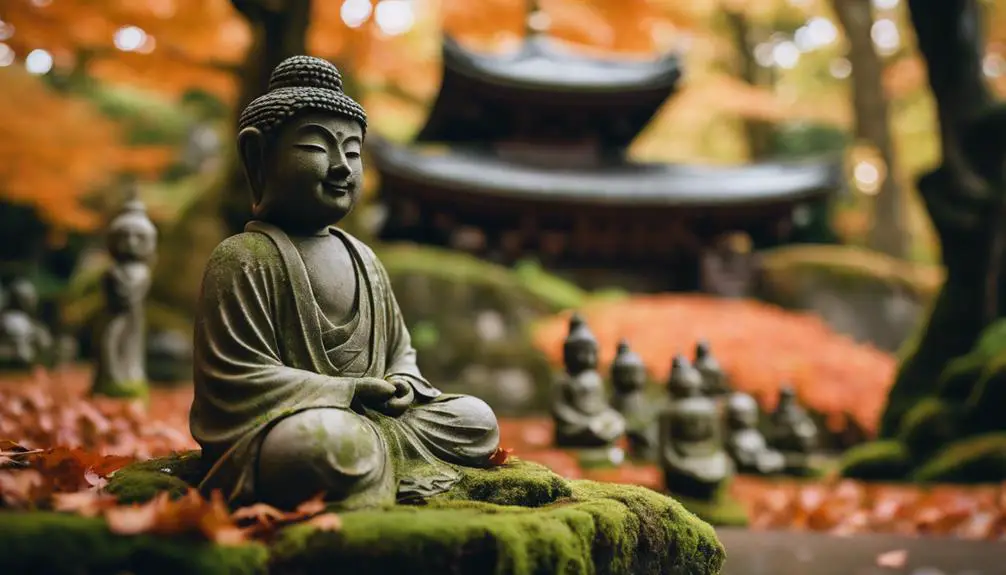
After exploring the tranquil heights of Kurama-dera, you'll find a starkly different charm awaiting at Otagi Nenbutsu-ji, renowned for its enchanting collection of stone statues. Nestled in the scenic Arashiyama neighborhood, this temple offers a unique visual feast unlike any other in Kyoto.
As you wander through the moss-covered grounds, you'll encounter over 1,200 rakan statues, each representing a disciple of Buddha. These statues aren't only a demonstration of faith but also of artistry, each carved with distinct expressions and poses that capture a wide range of human emotions. It's as if each figure has its own story to tell, inviting you to pause and ponder.
Here's what makes the statues at Otagi Nenbutsu-ji so special:
- Variety of Expressions: From serene smiles to playful grins, the emotional diversity is striking.
- Intricate Details: Notice the fine craftsmanship in the folds of their robes and the textures of their hair.
- Interaction with Nature: Over time, nature has embraced these figures, with moss gently adorning their surfaces, blending art with the natural world.
- Symbolism: Each statue is a representation of human virtues and vices, offering a reflection on life itself.
This hidden gem invites you to slow down and appreciate the blend of spiritual significance and artistic beauty.
Gio-ji Moss Garden
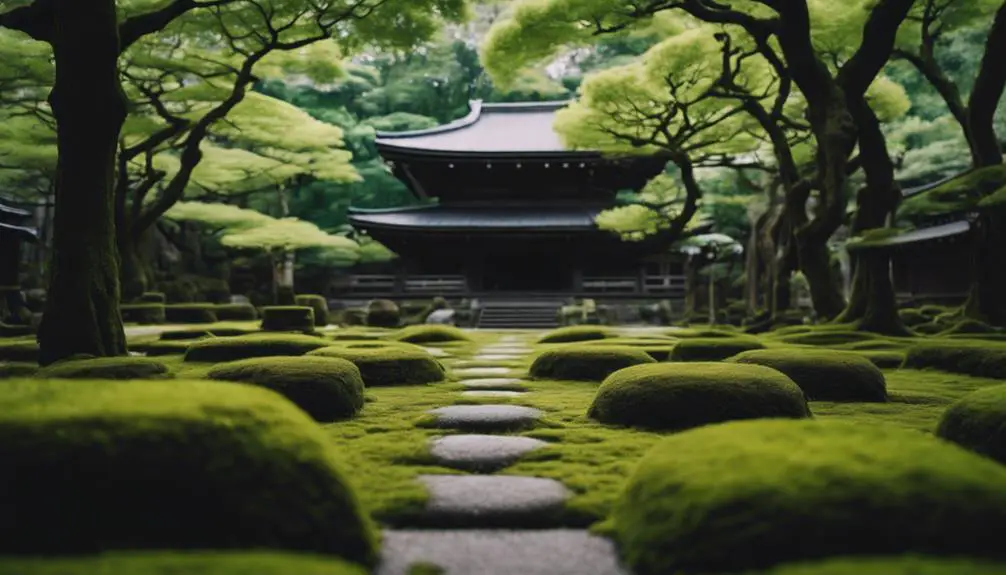
Continuing your journey through Kyoto's hidden treasures, you'll discover the serene beauty of Gio-ji Moss Garden. Tucked away in the Arashiyama district, this enchanting spot offers a tranquil escape from the bustling city life. As you step into Gio-ji, you're greeted by a thick carpet of vibrant green moss, enveloping the garden in a soft, verdant blanket.
The garden isn't large, but its impact is profound. Thick moss covers the ground, and tall trees cast a permanent shade, creating a mysterious, almost otherworldly atmosphere. You'll notice a small thatched hut and several stone statues peeking through the greenery, adding to the garden's mystical aura.
A narrow pathway winds through the moss, inviting you to explore further. You can't help but feel a sense of peace as you wander, the soft moss underfoot and the sound of a small stream nearby. It's a place where you can slow down, breathe deeply, and lose yourself in thought.
Gio-ji isn't just a visual treat; it's a sensory experience. The smell of damp earth mixed with the fresh greenery will refresh you, making Gio-ji Moss Garden a must-visit for anyone seeking a moment of calm in Kyoto.
Kawai Kanjiro's House
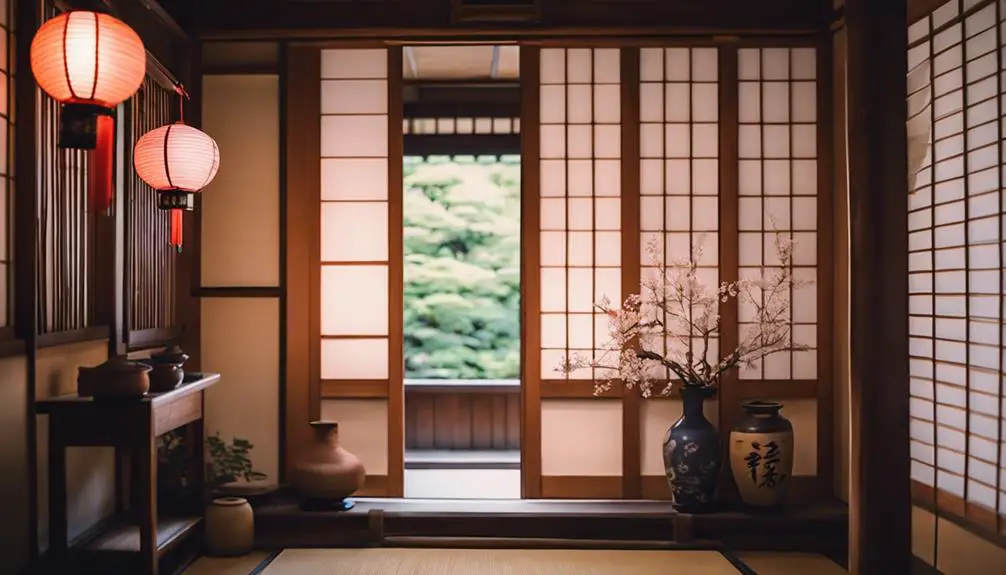
You'll next want to visit Kawai Kanjiro's House, a remarkable museum that was once the home of the celebrated ceramic artist, Kawai Kanjiro. Nestled in a quiet lane in Kyoto, this house-turned-museum encapsulates the spirit and creativity of Kanjiro, who was a key figure in the Mingei folk art movement in Japan. As you wander through the various rooms, you'll feel as if Kanjiro himself might still be at work, his presence almost palpable among his well-preserved tools, pottery wheels, and kilns.
Here's what you shouldn't miss:
- The Pottery Studio: The heart of Kanjiro's artistic life, where you can see the kilns and tools he used to create his famous ceramics.
- The Exhibition Room: Displays a rotating selection of Kanjiro's works—ranging from ceramics to wood carvings and calligraphy.
- The Living Quarters: Offering a glimpse into the daily life of the artist, preserved just as he left it.
- The Courtyard Garden: A serene spot that reflects the traditional Japanese aesthetic, perfect for a moment of reflection.
Each element of the house tells a story, not just of a man's talent, but of his philosophy and way of life. Don't rush your visit—take your time to soak in the artistry and history that permeate this unique space.
Shimogamo Shrine's Lesser Paths
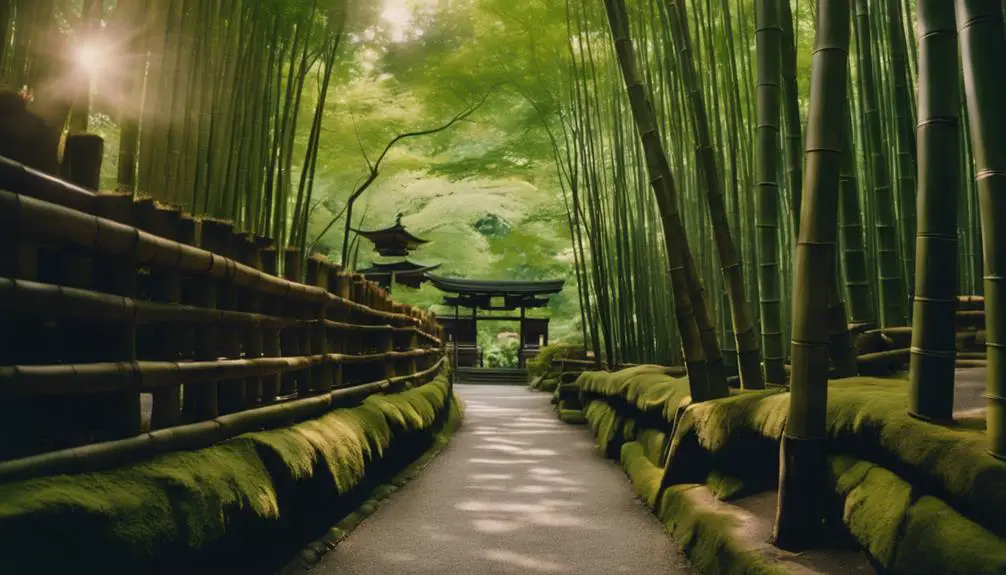
If you're intrigued by hidden spiritual retreats, Shimogamo Shrine's lesser-known paths offer a tranquil escape from Kyoto's bustling streets. Nestled in the ancient Tadasu no Mori forest, these paths wind through a timeless canopy of trees, connecting you with nature and the divine. It's not just a walk; it's a journey into the spiritual heart of Kyoto.
As you meander along these secluded trails, you'll find smaller shrines and sacred stones that most tourists miss. These are spots soaked in legend, where locals come to whisper prayers or simply sit in peaceful contemplation. It's the perfect place to slow down and let the mystique of the shrine envelop you.
Don't miss the Mitarashi River running along the edge of these paths. Its clear waters are believed to purify the soul, and you'll see why as the serene environment washes over you, leaving a sense of calm and renewal. Take a moment to dip your hands in the cool water—it's a revitalizing ritual that connects you to centuries of tradition.
Exploring these paths gives you a unique glimpse into the quieter, sacred side of Kyoto, far removed from the usual tourist paths. It's a deeply personal experience, one that offers a rare, introspective look at Japan's cultural and spiritual lineage.
Demachi Masugata Shopping Arcade
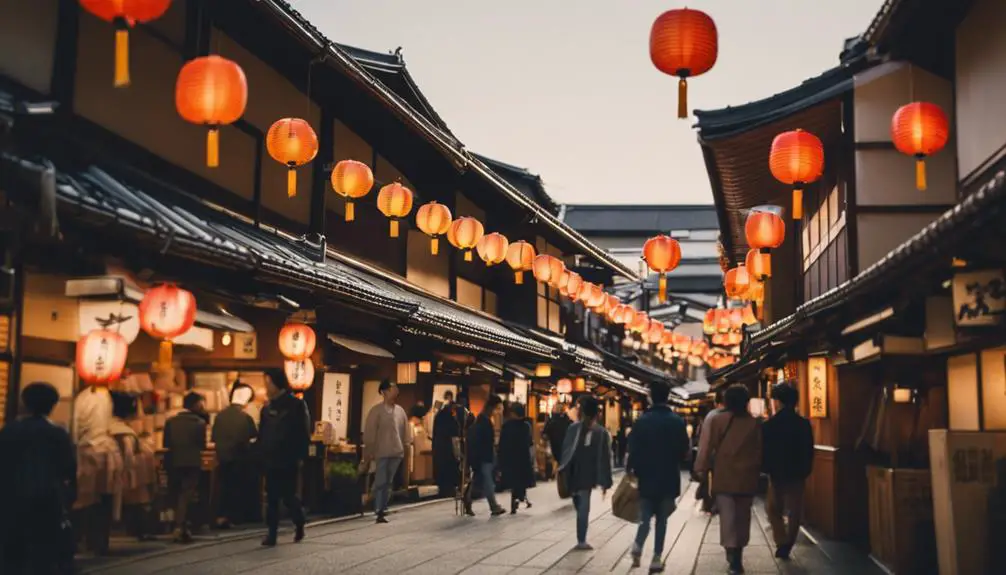
Step off the beaten path and into Demachi Masugata Shopping Arcade, a bustling hub where locals shop and socialize. Tucked away in the northern part of Kyoto, this arcade offers a glimpse into the everyday life of Kyoto residents, far from the tourist-packed sites. You'll feel the authentic charm as you wander through this covered market.
The arcade brims with shops that cater to every need and taste. You'll find everything from fresh produce to traditional sweets, making it the perfect spot to snatch up ingredients for a picnic or gifts to take home.
Here are four must-visit stops within the arcade:
- Tsujiya Butcher Shop – Grab some locally-sourced meat, known for its freshness and quality.
- Tanaka Fish Market – Explore a variety of seafood that's often caught the same day.
- Yamamoto Tea Store – Sample and purchase some of the finest Japanese teas.
- Sugimoto Confectionery – Treat yourself to traditional Kyoto sweets, perfect for an afternoon snack.
As you interact with friendly vendors and soak up the lively atmosphere, you'll truly connect with the Kyoto that locals love. This arcade isn't just a market; it's a vibrant part of community life.
Yoshimine-dera Temple Grounds
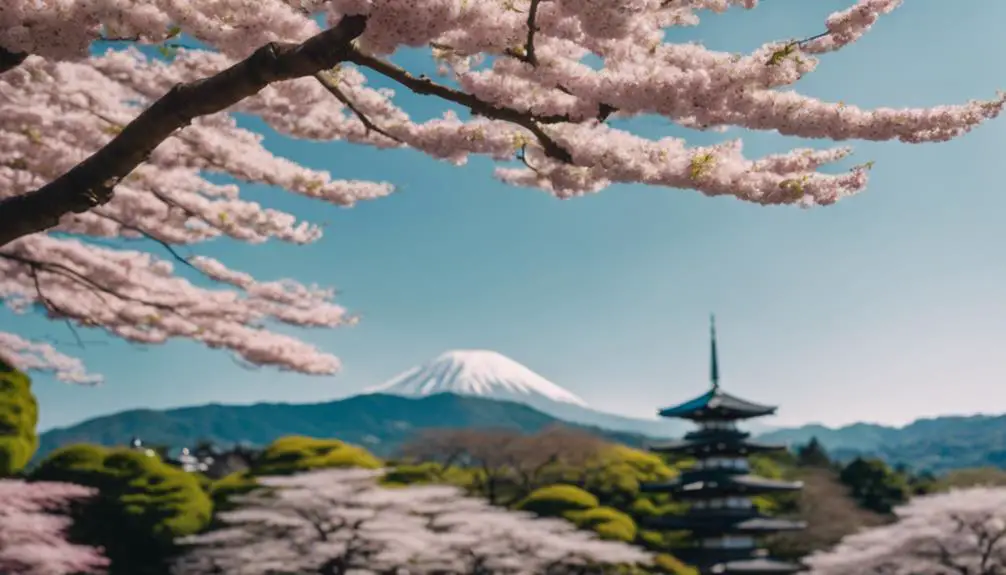
Discover the serene beauty of Yoshimine-dera Temple Grounds, nestled on the western outskirts of Kyoto. As you stroll through this less-trodden path, you'll be enveloped by the lush greenery that adorns the temple's expansive landscape. Established in the 11th century, Yoshimine-dera is part of the Tendai sect of Buddhism and offers you a peaceful escape from the city's hustle.
The grounds are renowned for their seasonal transformations. In the early summer, you'll find hydrangeas blooming vibrantly, a sight that captivates photographers and nature enthusiasts alike. Come autumn, the area is a spectacle of fiery maple leaves, providing a perfect backdrop for contemplation or simply enjoying a quiet moment away from the crowd.
Don't miss the temple's unique features like the hanging wooden deck known as “kakezuka,” where you can gaze out over the valley. It's an ideal spot for reflection or meditation. The statues and smaller sub-temples scattered throughout the grounds also contribute to the mystical atmosphere of the place.
Take your time to explore the hidden corners of Yoshimine-dera Temple Grounds. You'll discover not just breathtaking scenery, but a deeper sense of tranquility that stays with you long after your visit.
Keage Incline in Spring
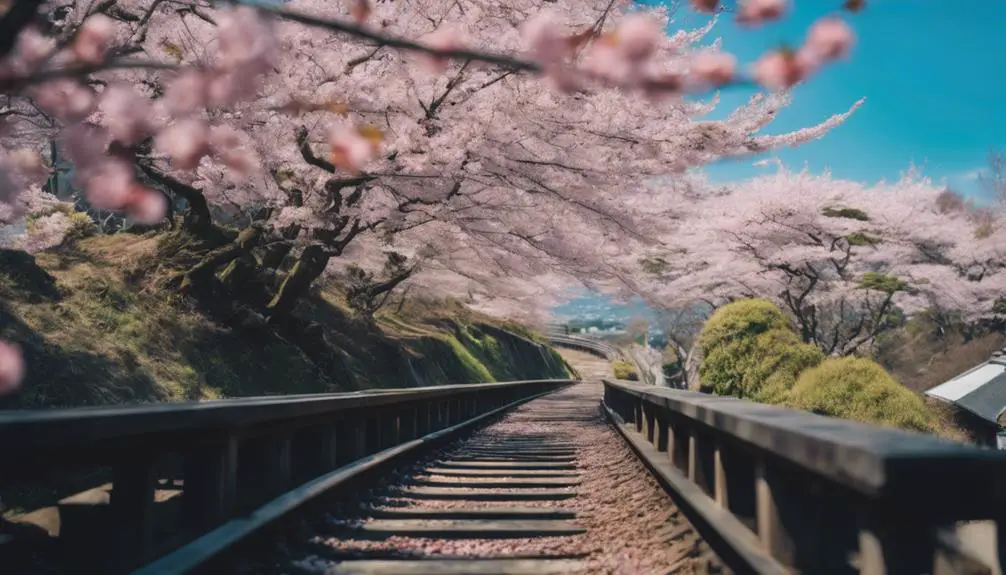
In spring, Keage Incline transforms into a breathtaking tapestry of cherry blossoms, inviting you to experience its unique beauty. Once a functional railway slope used to transport boats between canals, this historical site now serves as one of Kyoto's less celebrated yet stunningly picturesque spots during cherry blossom season.
As you stroll along the old tracks, you're enveloped by a canopy of soft pink blooms, creating an almost magical atmosphere that feels like stepping into a painting.
Here's why you shouldn't miss visiting Keage Incline in spring:
- Photographic Paradise: The alignment of cherry trees along the tracks offers a perfect frame for both amateur and professional photographers.
- Quiet Reflection: Unlike more crowded spots, Keage Incline provides a peaceful escape where you can enjoy the scenery without the hustle.
- Historical Context: Learning about its past as a transport route adds an educational layer to your visit.
- Accessibility: It's easily reachable by public transport and offers a flat pathway, making it accessible for everyone, including those with mobility issues.
Don't just stick to the popular paths; Keage Incline's blend of natural beauty and historical intrigue awaits your discovery. Make sure you bring your camera and a sense of wonder.
Philosopher's Path Less Traveled
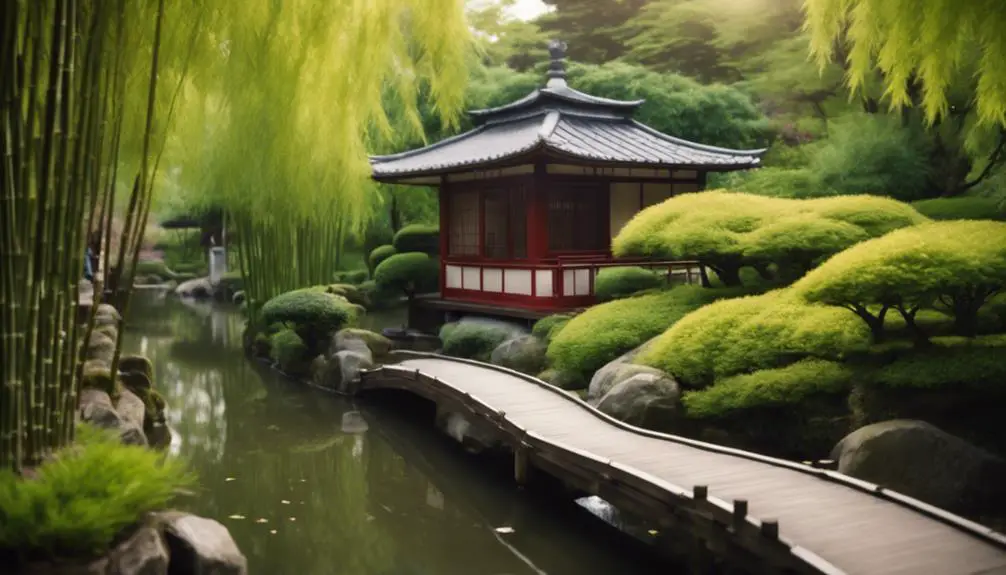
Explore the Philosopher's Path, a tranquil route often overlooked by tourists, where you can immerse yourself in the serene beauty of Kyoto's natural and intellectual heritage. This path, less crowded than the city's more famous sites, follows a cherry tree-lined canal, offering a peaceful walk through what feels like the heart of traditional Japan. As you stroll along, you'll understand why this path was a favorite of Nishida Kitaro, one of Japan's most famous philosophers, who reportedly used this route for daily meditation.
You'll find the path in the northern part of the city, starting near Ginkaku-ji (Silver Pavilion) and stretching about two kilometers to the neighborhood of Nanzen-ji. The walk is particularly magical in early spring when the cherry blossoms are in full bloom, but its beauty remains year-round with shifting colors and light. It's not just the natural beauty that will captivate you, but also the small temples and cafes tucked away, just off the path, waiting to be discovered.
Take your time, pause to watch the ducks glide by in the canal, and perhaps reflect a little yourself. You'll leave feeling refreshed and connected to the deeper, quieter spirit of Kyoto.
Rakushisha Poet's Hut
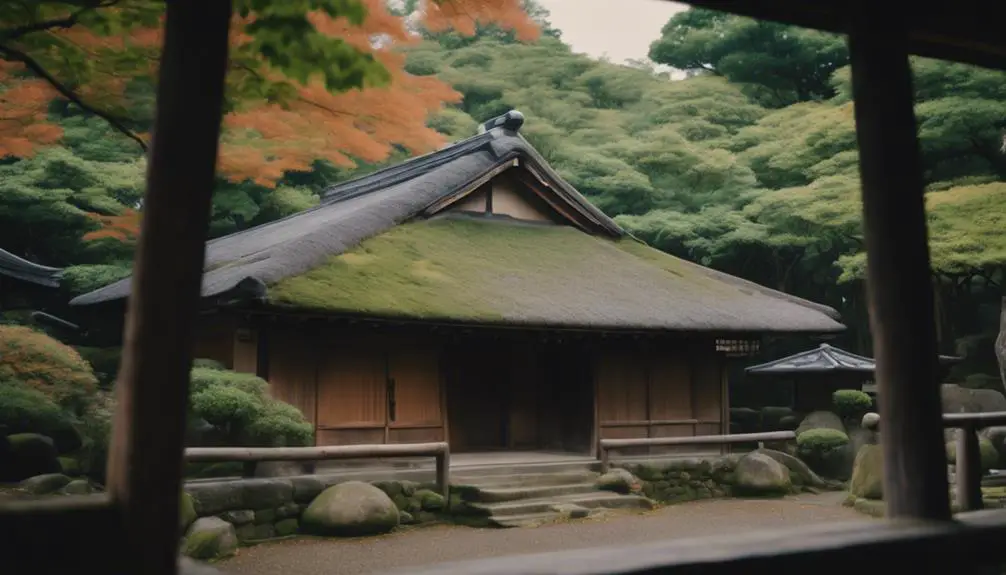
Immerse yourself in the tranquility of Rakushisha Poet's Hut, where the simplicity of its surroundings inspired some of Japan's most cherished haiku. Nestled on the outskirts of Kyoto, this humble abode was once the retreat of Mukai Kyorai, a prominent haiku poet and disciple of the legendary Matsuo Basho. As you explore the modest thatched-roof house, you'll feel as if you've stepped back in time, enveloped by the calmness that fueled countless poetic masterpieces.
Rakushisha translates to 'The Hut of Fallen Persimmons,' a name derived from an unfortunate event where a storm knocked down all the ripe persimmons the poet was planning to sell. This incident, however, turned into a source of artistic inspiration, emphasizing the beauty of impermanence—a core tenet of haiku poetry.
Here are four must-see aspects when you visit:
- The calligraphy brushes and ink stones—tools of the poet's trade—meticulously preserved.
- The guestbook signed by visitors from around the world, showcasing the global appeal of haiku.
- The serene garden, perfect for reflection and perhaps composing your own haiku.
- Seasonal displays of persimmons, connecting the past with the present.
Rakushisha isn't just a historical site; it's a continuation of the poetic spirit. Immerse yourself in the quietude and perhaps leave with poetic inspiration of your own.
